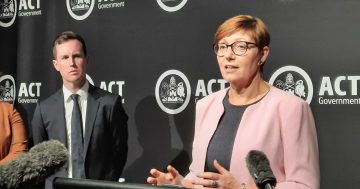
The ACT Government expects COVID-19 will need to be managed with appropriate legislation for the next few years. Photo: Michelle Kroll.
Chief Minister Andrew Barr has painted a bleak portrait of the next few years, telling a committee inquiry earlier this week (1 February) that appropriate legislation must be in place so the government can manage the “peaks and troughs” of the pandemic for “years to come”.
Currently, specific legislation intended to allow the government to make public health directions when a public health emergency has passed is going through public hearings before it is debated in the Assembly later in the year.
“Based on where we are now and the experience of the last two years, and what’s being forecast that lies ahead of us, is that we will be dealing with COVID-19 as a significant issue for many, many years to come,” Mr Barr stated.
“There will be peaks and troughs. There will be new variants and new waves … this is not going away.”
For this reason, the ACT Government is attempting to pass ‘fit-for-purpose’ legislation to manage the COVID-19 pandemic when it’s no longer considered an ’emergency’ situation.

Minister for Health Rachel Stephen-Smith and Chief Minister Andrew Barr said there will be challenging periods ahead. Photo: Michelle Kroll.
Both Mr Barr and Ms Stephen-Smith were clear the next few years would be unlikely to follow a linear path, and it will always be possible to shift from a management situation back to an emergency one and vice versa.
“[This bill] was introduced pre-Omicron, in an environment where we thought we’d be moving to a relatively low-level of cases in the community and trying to manage [these cases],” Ms Stephen-Smith said.
“The reality is where we are now is genuinely a health emergency.”
Ms Stephen-Smith said it was likely some periods would be more challenging, especially if the Northern Hemisphere’s experience in the winter months was anything to go by.
As has long been the style of the ACT’s authorities, Mr Barr wouldn’t put a number on what caseloads would trigger a move from one scenario to another.
“That’s obviously a difficult question to answer in an absolute black and white fashion. There wouldn’t be any one particular number that would dictate one decision or the other.
“Clearly, there are a range of considerations that would be before the Chief Health Officer, before the cabinet, and indeed before the Assembly that would pertain to both local, national and global information,” Mr Barr said.
He noted that various factors such as caseloads, hospital admissions, the impact on the health system and community wellbeing would all be taken into account.
The current Public Health Emergency Declaration is due to end on 12 February, although it’s highly likely it will be extended. The ACT has been in a continuous state of emergency since 16 March 2020.
Under the new legislation, the government could declare public health directions such as mandating vaccines, masks, quarantine and density limits. However, another lockdown couldn’t be put in place.
While the Chief Health Officer will retain a central role, the ultimate power to make public health directions would rest with the Executive.
“If we think about the way we have been managing, and are currently managing the pandemic, that’s effectively been ‘test, trace, isolate and quarantine’ directions that need a health judgment from the health officer and are not so much about balancing the social and economic impacts,” Ms Stephen-Smith explained.
“I think people are looking for that accountability around those decisions that have a specific social and economic impact.”
The bill will be debated in the Assembly later in the year.




















